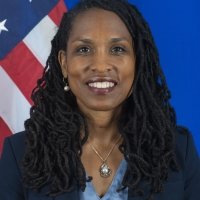Ground Truth Briefing: Is Climate-Related Migration a National Security Issue?

In this conversation, three veteran analysts of climate change and migration discuss the impact upon national and international security - and what policymakers should do about it.
The Takeaways
Experts predict that environmental changes, including climate change, will spur some people to leave their homes and countries. But will climate-related migration lead to conflict?
On February 28, the Wilson Center’s Roger-Mark De Souza moderated a discussion on the short- and long-range impacts of climate migration. Joining him were Maxine Burkett, a Wilson Center global fellow and associate professor of law at the University of Hawaii at Mānoa; Joseph Cassidy, a Wilson fellow and former director for policy, regional, and functional organizations at the U.S. Department of State; and Sherri Goodman, a Wilson fellow and former deputy under secretary of defense for environmental security at the U.S. Department of Defense.
A recent Wilson Center report, Navigating Complexity, found relatively broad consensus that climate change will lead to more migration and that climate is a "threat multiplier" for conflict. However, it also found many unanswered questions and surprising misconceptions about the interactions between climate change, migration, and conflict.
Roger-Mark De Souza began the discussion by noting that one should be careful when using the term “climate refugee.” According to the United Nations, “nearly 75 percent of migration actually occurs within a state’s borders,” he said. De Souza also highlighted that climate migration is not always a negative occurrence. “Migration can be a peaceful and successful way to achieve climate adaptation.”
Maxine Burkett said the term “refugee” has a very specific legal definition that brings with it certain obligations. Using the term to apply to people displaced by the effects of climate change is not correct, given the current Refugee Convention.
Forced migration or displacement may be more appropriate, but Burkett noted that, “we don’t really have a good grasp on how many people are being forced to migrate [by climate change] and what these impacts would be on conflicts and violence.”
“We are concerned about regions that have a dense population – Southeast Asia and South Asia are critical areas,” she said. “Also in areas of the former Soviet Union where glacial melt is causing increased resource conflicts. These glacial melt problems are also being seen in South America as well.”
Burkett explained that, “often uncertainty about your security and your future is one of the most critical factors that can lead to violent conflict, this includes perceived insecurity, which in many cases is more difficult than the actual security risk.”
The term “relocation” implies a more coordinated response. National governments often move populations out of harm’s way in response to short-term term natural disasters, like hurricanes, but also increasingly in response to long-term changes, like sea-level rise, such as some Pacific island nations and the Mekong Delta.
Three Categories of Risk
Joseph Cassidy distinguished three categories of risks from climate-induced migration. First, there are direct costs, like those associated with humanitarian assistance or border enforcement, such as the outlay to build a wall on the southern border of the United States to deal with migration from Central and South America.
Second, there are indirect risks, as when terrorist groups use mass migration to infiltrate new areas of operation or derive revenue from migrant smuggling. Climate induced migration can also damage the global economy, through trade distortion and under-productivity. It can even harm our multilateral diplomacy, if we lose supportive partners at the UN: “If there are certain low-lying island states that blink out of existence in the next hundred years, one of the consequences is to our diplomatic efforts internationally.”
Finally, there are third-order risks from how states might respond to climate-induced migration. The United States military could be drawn into or stressed by conflicts exacerbated by climate-related migration. Cassidy also noted possible costs to national reputation and social instability. The risk is that “people and governments make poor choices under stress, yielding unintended consequences” as with recent visa restrictions that have undermined our universities, tourism, and tech companies.
“The U.S government isn’t structured properly to think in long-term strategic ways when dealing with issues as large as climate change and migration,” Cassidy said. “The National Security Council skews toward hard power because it’s much more visible to senior officials and policymakers.” That can push slow-burn issues like migration and the effects of climate change to the side. Cassidy warned that reducing the budget for foreign aid and the State Department would not help encourage strategic thinking.
The structure of the international community is also not always conducive to long term solutions to major problems. Multilateral agencies are too often stove-piped, international law is antiquated in some cases, collective action problems derive from the different capabilities of states and how they are affected, and migrants have strong incentives to take grave risks.
New Military Missions
Sherri Goodman noted that the U.S. military, for its part, has made strides in incorporating climate change into its planning and operations. Five years ago the Department of Defense officially recognized climate change as a “threat multiplier,” and new Secretary of Defense James Mattis has argued that climate change must be addressed.
Goodman noted there are five key areas in which climate change is affecting the military.
First, there is an increased “demand signal” for missions that provide humanitarian relief and related capacity training. “In many cases, the U.S. military is the only available option for a rapid response to a natural disaster,” she said.
Second, there is increased instability in areas of key strategic importance for the United States. This includes conflicts springing from severe droughts, such as in Syria and Darfur.
Third, climate change is requiring “forward presence” in new regions, like the Arctic, with its increasing viable sea lanes. This requires new equipment, new bases, and new partnerships.
Fourth, climate change is affecting the availability and viability of military installations, which train, house, and support soldiers and equipment. Goodman highlighted increased “sunny day” flooding in the Norfolk area, the largest naval base in the world, which faces significant sea-level rise and subsidence-related challenges.
Finally, training exercises have been affected by climate change, said Goodman. This includes so-called “black flag” days, when temperatures are above a certain level and certain activities must be cancelled.
Speakers


Former Director for Policy, Regional, and Functional Organizations, International Organizations Bureau, U.S. Department of State

Author, Threat Multiplier: Climate, Military Leadership & the Fight for Global Security.
Moderator

Vice President, Sustainable Markets, Pact
Hosted By

Environmental Change and Security Program
The Environmental Change and Security Program (ECSP) explores the connections between environmental change, health, and population dynamics and their links to conflict, human insecurity, and foreign policy. Read more
